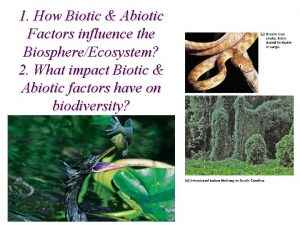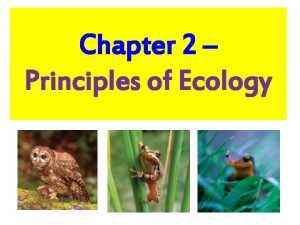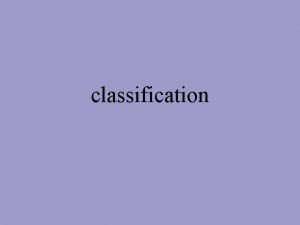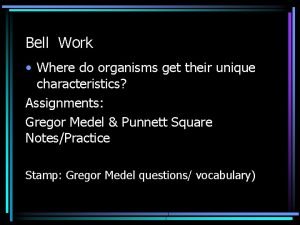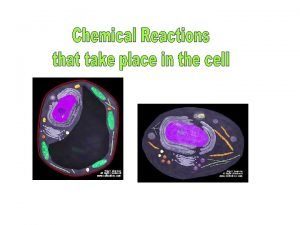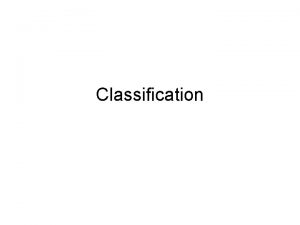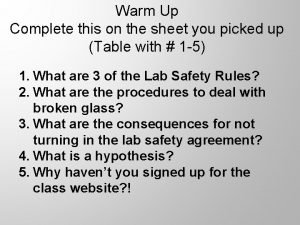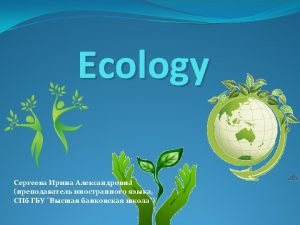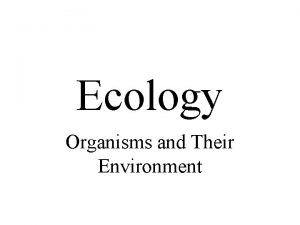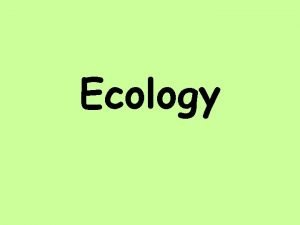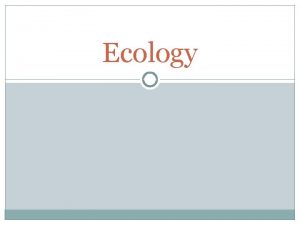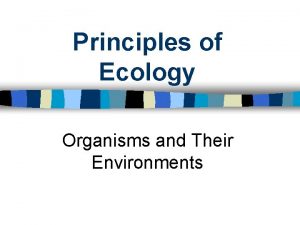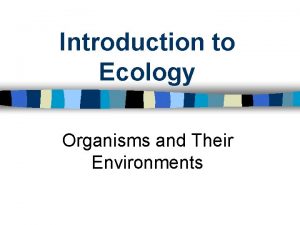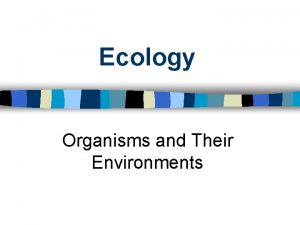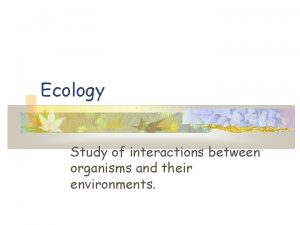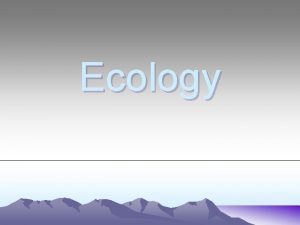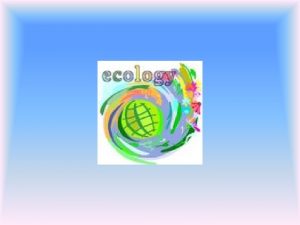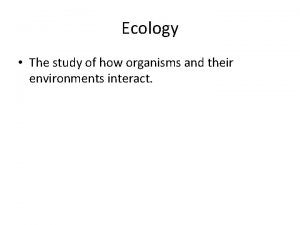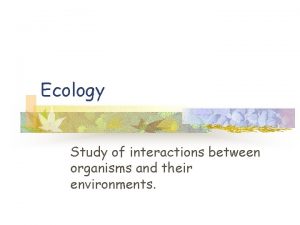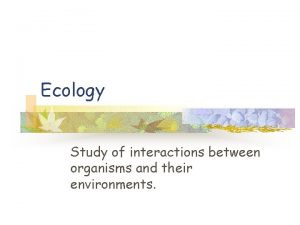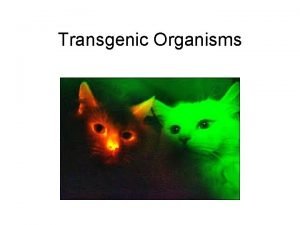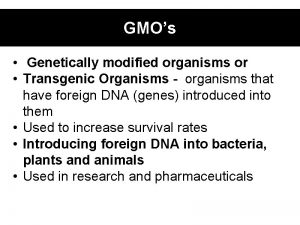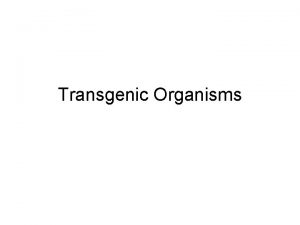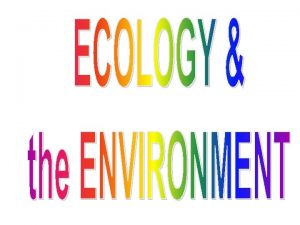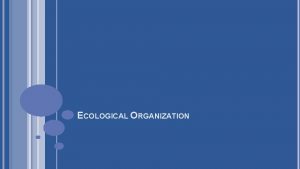ECOLOGY Ecology The study of organisms and their

























- Slides: 25

ECOLOGY

Ecology • The study of organisms and their interactions with the environment • The biosphere is all the land, water and air in which organisms live. • All the living parts of an environment are called biotic factors. The nonliving parts are called abiotic factors (ex: water, light, etc. )

Levels of Organization in the Biosphere • Population: consists of all the members of a single species that live in one area • Community: all populations that live and interact in one environment • Ecosystem: community + abiotic factors; ex: forest, desert, ocean

Cycles • Matter is recycled within and between ecosystems • Biogeochemical cycles show matter cycles through the biosphere • There are 4 types of cycles: – Water cycle – Carbon cycle – Nitrogen cycle – Phosphorous cycle

Some Terms • Habitat: type of environment in which a particular species lives • Niche: full range of physical and biological conditions in which an organism lives and the way in which the organism uses those conditions • Biodiversity: the variety of life--the different plants, animals and microorganisms--and the ecosystems of which they are a part

Food Synthesis • Photosynthesis: use of light energy to make food; process used by plants, algae and some bacteria • Chemosynthesis: use of chemical energy to make food; process used by some bacteria

Remember • Autotrophs: use light energy to make their own food; also called producers • Heterotrophs: can’t make their own food; also called consumers

Types of Heterotrophs • Herbivores: eat plants • Carnivores: eat animals • Omnivores: eat both plants and animals • Decomposers: break down organic matter • Scavengers: eat tissues of dead animals

Community Interactions • Competition: organisms attempt to use an ecological resource in the same place at the same time • Symbiosis: any relationship in which 2 species live closely together • Predation: interaction in which one organism (predator) captures and feeds on another organism (prey)

Types of Symbiotic Relationships • Mutualism: both organisms benefit • Parasitism: one organism benefits while the other is harmed • Commensalism: one organism benefits while the other is neither harmed nor benefited

Food Chains • A food chain models the flow of energy through organisms in a community • The flow is in one direction • Each step in the transfer of energy and matter in an ecological community is called a trophic level • Only 10% of the energy from one level is transferred to the level above it

F O O D C H A I N

Food Web • Shows how food chains are connected

Ecological Pyramids • Show the relationship between producers and consumers at the trophic levels in an ecosystem • There are 3 types of pyramids: – Energy Pyramid – Biomass Pyramid – Pyramid of Numbers

Growth Rate • Growth rate = change in the number of individuals divided by the time period • Factors that play a role in growth rate: – Birth rate – Immigration—movement of individuals into an area – Emigration—movement of individuals out of an area – Death rate

Exponential Growth • Occurs when individuals • • in a population reproduce at a constant rate Under ideal conditions with unlimited resources, a population will grow exponentially As resources become less available, the growth of a population slows or stops The red bracket shows the area of the graph that represents exponential growth.

Carrying Capacity • The number of individuals • in a population that an environment can support over a relatively long period of time Determined by limiting factors • Limiting factors are biotic and abiotic resources in the environment that limit the size of a population The red bracket shows the area of the graph that represents the carrying capacity.

Density-Dependent Limiting Factors • Factors that become limiting only when the population is large • They include: – Living space – Disease – Competition – Predation

Density-Independent Limiting Factors • Factors that affect all populations in the same way, regardless of their size • They include: – Weather – Seasonal cycles – Natural disasters

Ecological Succession • As an ecosystem changes, older inhabitants gradually die out and new organisms move in • This series of predictable changes that occurs in a community over time is called ecological succession • There are 2 types: – Primary succession – Secondary succession

Primary Succession • Occurs where no soil exists • Ex: occurs on surfaces formed by volcanic eruptions or on bare rock exposed when glaciers melt

Primary Succession

Secondary Succession • Occurs when a disturbance of some kind changes an existing community without removing the soil • Ex: wildfires burn woodlands or field is cleared for farming and then abandoned

Secondary Succession

Biological Magnification • Buildup of a pollutant in organisms at higher trophic levels in a food chain ppm=parts per million
 Section 1 organisms and their relationships
Section 1 organisms and their relationships Section 1 organisms and their relationships
Section 1 organisms and their relationships Unicellular and multicellular
Unicellular and multicellular Member of the same species
Member of the same species Organisms ecology
Organisms ecology Principles of ecology section 2 flow of energy
Principles of ecology section 2 flow of energy Principles of ecology section 2 flow of energy
Principles of ecology section 2 flow of energy Principles of ecology chapter 2
Principles of ecology chapter 2 5 levels of organisms
5 levels of organisms Chapter 2 section 1 organisms and their relationships
Chapter 2 section 1 organisms and their relationships Taxonomy is the science of grouping and naming organisms
Taxonomy is the science of grouping and naming organisms This is the study of grouping and naming organisms
This is the study of grouping and naming organisms Where do organisms get their traits?
Where do organisms get their traits? Where do all organisms get their energy
Where do all organisms get their energy The process of grouping things based on similarities
The process of grouping things based on similarities Organisms that make their own food
Organisms that make their own food Biology ecology study guide answer key
Biology ecology study guide answer key Section 1 community ecology
Section 1 community ecology Ecology is the study that helps to preserve
Ecology is the study that helps to preserve Translation of romeo and juliet act 1
Translation of romeo and juliet act 1 Hát kết hợp bộ gõ cơ thể
Hát kết hợp bộ gõ cơ thể Lp html
Lp html Bổ thể
Bổ thể Tỉ lệ cơ thể trẻ em
Tỉ lệ cơ thể trẻ em Gấu đi như thế nào
Gấu đi như thế nào Tư thế worms-breton
Tư thế worms-breton








